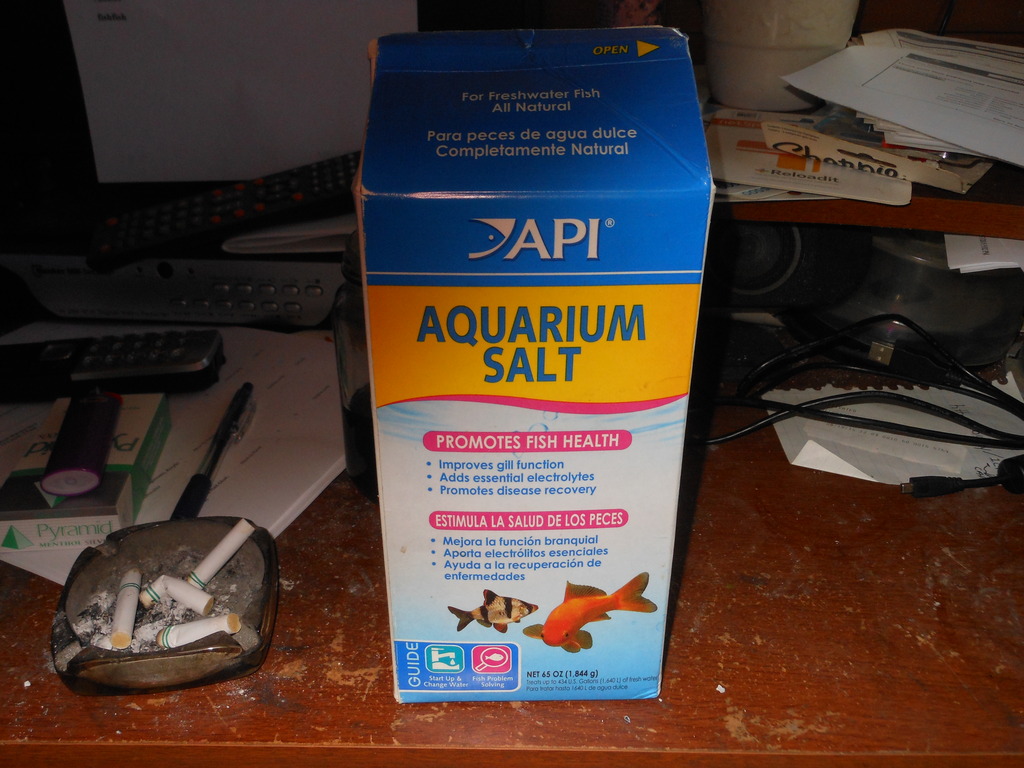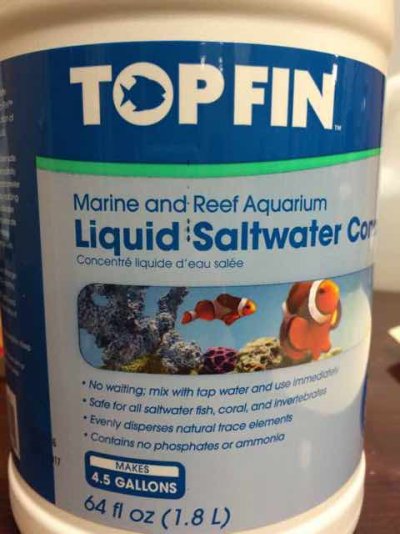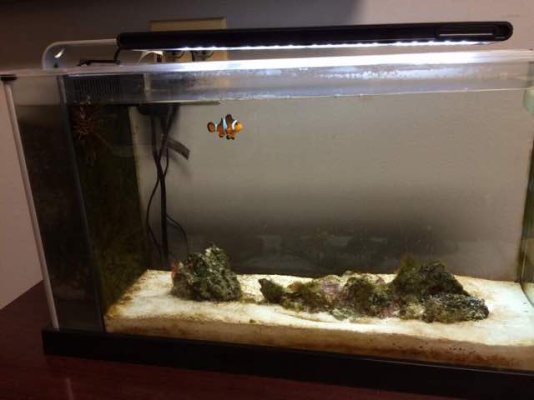Not worth the bottle it's in this kind of additive is worthless bring more issues than it's worth , it also don,t contain the salt you need ,
cayno: all that brown crud on the sand and rock
Remedy: bigger water changes siphon out brown crud during water change try not to remove the sand , lighten up on feeding with the stock in the tank I would feed less 1/4 cube maybe 2 x a week , shorter light cycle or none till clears up
Invest in: test kit and hydrometer and a salt mix instant ocean has a 50g bag you can get it at petco, I don't see a heater need one those also ideal temp 78*to 80* you could also use a power head or so to circulate the tank
here's a good basic learners guide to help understand the basics
Saltwater Aquariums For Dummies
From
Saltwater Aquariums For Dummies, 2nd Edition by Gregory Skomal
Keeping a saltwater aquarium means maintaining a fairly strict maintenance schedule to keep the life inside healthy. The water in saltwater aquariums requires regular testing for a variety of minerals and chemical balances. Figuring out the right feeding schedule and amount for your fish is a task that needs attention when you first stock your aquarium and when the population changes.
Maintenance Schedule for Your Saltwater Aquarium
To keep the fish and other marine life in your saltwater aquarium happy and healthy, you have to do some basic maintenance. Some tasks you need to do every day without fail; other jobs you do weekly, bi-weekly, or monthly. And every three months you need to conduct a thorough examination of all aquarium systems, including lighting, heating, filtration, aeration pumps, and tubing. Replace or clean parts as needed.
The following table shows the tasks to do on a continuing basis:
Every Day Once a Week Every Two Weeks Every Month Turn the query lights on and off. Most aquarists prefer to use an automatic timer. If you choose not to, try to turn the lights on and off in a consistent pattern. Remove excess algae Clean filters as needed. Partially change or rinse the filter media on some filters, if the bioload is high, the media is dirty, or the flow is restricted. Conduct thorough filter checks. Replace the filter carbon and rinse the filter media and components, as needed and depending on bioload. Check for fish and invertebrates for signs of stress, diseased, or death. Be prepared to remove or treat fish that aren’t well. Clean the glass Change twenty percent of the tank water while vacuuming the gravel. Clean the protein skimmer. Feed the fishes and invertebrates twice a day, removing any uneaten food. Conduct water tests weekly after the water matures and the nitrogen cycle is established. Record all test results and add trace elements and buffers.
Replace air stones as needed. Conduct water tests until the water matures and the nitrogen cycle is established. Routine tests include ammonia, nitrite, nitrate, and pH. Record the test results. Remove excess algae.
Clean the outside of the aquarium, removing salt and calcium deposits, dust, and dirt. Check the water temperature and specific gravity or salinity. Adjust the heater as needed.
Rinse any tape decorations that suffer from excess algae. Empty the protein skimmer collection cup as needed.
Check the water level and top off as needed with fresh RO/DI water.(no salt)
Check all aquarium systems: heater, filters, aerators, protein skimmer. Make sure they’re running properly and smoothly and pay special attention to intakes and siphon tubes. Make sure nothing is leaking and clean everything as needed.
How to Feed the Fish in Your Saltwater Aquarium
Develop a working sense of how much and how often to feed the fish in your saltwater aquarium. Use the guidelines in the following list and keep in mind that it's definitely better to feed them too little at first than too much.
- Offer as much food as your fish will eat in five minutes. Food should sink no deeper than one third the height of the tank. Provide tablets, pellets, or sinking food for bottom fish and invertebrates.
- Feed your food in very small portions over the five-minute period. If any food is left over after this time, you are an overfeeder.
Some foods, such as lettuce and spinach, are nibbled over time, so the five-minute rule does not apply.
- If you're home during the day, feed your fish and invertebrates very small portions over the course of the day. feed them twice a week at the same time . Keep in mind if you only have one or two fish feed smaller portions
- Always feed your fish at the same spot in the tank. This lets you sneak food down to the bottom dwellers, while the surface fish are distracted.
- Don't overfeed the fish, no matter how much you think they need more food. Overeating stresses your fish and causes detritus to accumulate in the tank (nitrates/phosphates), degrading water quality.
Test Kits for Testing Water in Saltwater Aquariums
You can't visually determine the pH balance of the water in your saltwater aquarium. To maintain healthy levels of chemicals and minerals in saltwater aquariums, you have to test the water, and to do that, you have to buy test kits. Here's a general guide for purchasing test kits for your fish-only or reef tank. As your tank becomes more complicated, you can always add to your test-kit collection.
....
Fish-Only------------------------ Reef Tank
PH yes------------------------------yes
Ammonia yes------------------------yes
Nitrite yes---------------------------yes
Nitrate yes-------------------------- yes
Alkalinity optional--------------------yes
Copper no--------------------------no
(Never use copper in display tank)
Phosphate optional-------------------yes
Iodine no---------------------------optional
Calcium no------------------------- optional
Silica no----------------------------optional
Test kits are made so you don't have to be a chemist to use them. Although a couple of methods have been developed, the most common involves adding drops of the test chemical to an aquarium sample that changes the color of the water. You then match the watercolor with that on a color chart, which tells you the correct level of what you are testing.
a hydrometer is a must to maintain a steady salinity in your tank safe levels are between 1.021 and 1.026 but 1.025 is ideal ,



